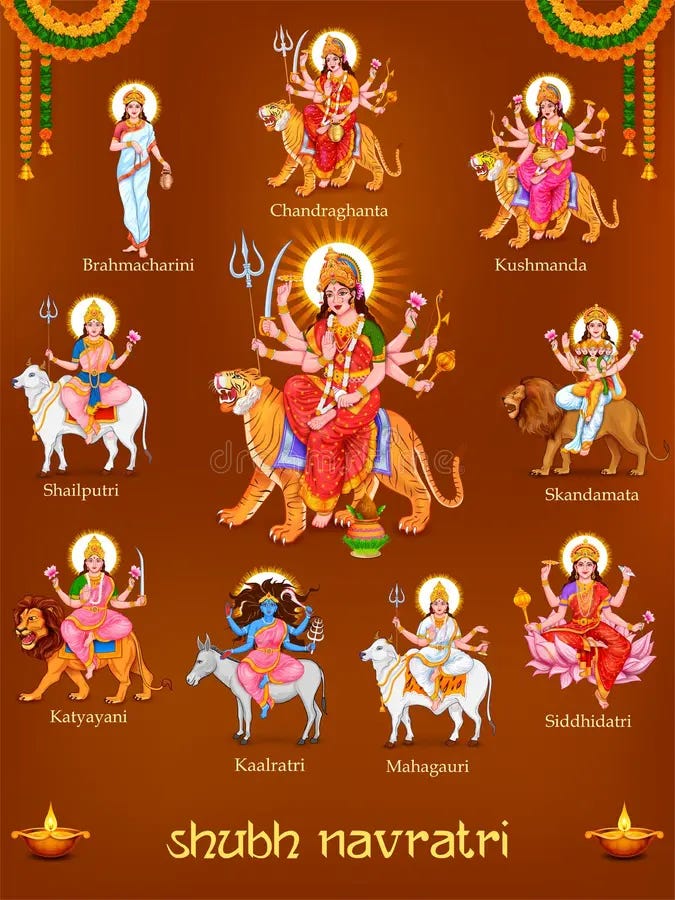Celebrate Navratri Story, Traditions, and Significance
People across India celebrate Navratri as one of the most vibrant festivals, dedicating nine nights to devotion, dancing, fasting, and cultural events honoring Goddess Durga. Celebrated twice a year—Chaitra Navratri in the spring and Sharad Navratri in the fall—Navratri symbolizes the multidimensional strength of the divine feminine and the victory of good over evil.
This blog post explores the rich cultural traditions, mythology, spiritual significance, and history of Navratri, and explains how people celebrate it across India.
The Story Behind Navratri
In Sanskrit, “Nav” means nine and “Ratri” means nights; together, Navratri means “Nine Nights.” During these nine nights and ten days, devotees worship nine different manifestations of Goddess Durga, known as Navadurga.
Mythological Significance
The most famous myth about Navratri is the battle between the buffalo demon Mahishasura and the goddess Durga. At the height of his power, the demon Mahishasura terrorized both the earth and the heavens, spreading fear and chaos everywhere.
Lord Brahma gave him a boon that no man or god could kill him, which made him practically invincible. The combined energies of Shiva, Vishnu, and Brahma produced Goddess Durga, a fierce warrior goddess with divine weapons, to vanquish this evil.
After nine nights of battle, Durga finally vanquished Mahishasura on the tenth day, also known as Vijayadashami or Dussehra. This triumph signifies the restoration of cosmic order (dharma) and the triumph of good over evil.
The Nine Forms of Goddess Durga (Navadurga)
People devote each day of Navratri to a different avatar of Durga, with each avatar embodying special qualities.
- Shailaputri – Daughter of the mountains, symbolizing nature.
- Brahmacharini – The goddess of penance and austerity.
- Chandraghanta – The warrior goddess representing bravery.
- Kushmanda – The goddess who created the universe with her smile.
- Skandamata – Mother of Lord Kartikeya, representing motherhood.
- Katyayani – The fierce form born from Sage Katyayana.
- Kalaratri – The Kali goddess who destroys evil spirits.
- Mahagauri – The goddess of purity and enlightenment.
- Siddhidatri – The giver of supernatural powers and blessings.

Spiritual Significance of Navratri
1. Worship of Shakti (Feminine Power)
Navratri celebrates Shakti, the primordial cosmic energy, and the power of women. It honors the goddess who protects, nurtures, and defeats evil, representing the balance between creation and destruction in the universe.
2. Detoxification and Renewal
During Navratri, devotees observe fasting and spiritual cleansing, just as the goddess purifies the universe. Moreover, by focusing on spiritual activities like prayer and meditation, they revitalize the body and mind; additionally, avoiding particular foods supports this renewal process.
3. Triumph of Good Over Evil
The festive customs serve as a reminder to develop virtues like compassion, courage, and virtue in order to overcome negativity and injustices in our lives and society.
Navratri Traditions and Rituals
Fasting
A nine-day partial or complete fast is observed by many devotees. The rules for fasting vary, ranging from eating only fruits and milk to eating specific vrat foods like sabudana khichdi or vrat rice made with amaranth. The goal is to develop discipline, self-control, and spiritual focus.
Daily Worship (Puja)
Every day, devotees carry out elaborate pujas that include singing bhajans, reciting mantras, offering flowers, fruits, and sweets, and adorning the altar with idols or pictures of the corresponding goddess forms.
Garba and Dandiya Raas
The Garba and Dandiya Raas dances bring evenings to life in Gujarat and many other Indian states. The energy of the goddess and the cyclical nature of time are symbolized by these traditional folk dances. Wearing colorful attire and dancing joyfully to devotional music, participants celebrate life and spirituality.
Kanya Puja
On the eighth or ninth day, young girls, who represent the goddess in her infantile form, are worshipped and offered gifts, new clothes, and food. This ritual honors women’s divinity and purity.
Decorations and Social Gatherings
Temples and homes are decorated with lights, flowers, and vibrant rangoli designs. Communities come together for cultural events, devotional singing, and feasting to deepen the bonds between family and friends.
Navratri Across India
Though its basic spiritual essence is universal, the celebration of Navratri reflects regional cultural diversity:
• North India: Pujas, fasting, and the Ram Lila plays, which depict Lord Rama vanquishing Ravana on Dussehra, are all highlighted.
• Gujarat, located in West India, is famous for its yearly Garba and Dandiya Raas dance festivals.
• East India (West Bengal, Odisha): Known as Durga Puja, this area worships idols and holds lavish cultural festivities in honor of Durga.
• South India: Worshiping different goddesses and community get-togethers are valued.
The Health Advantages of Navratri Fasting
Along with its spiritual benefits, Navratri fasting promotes improved digestion, detoxification, and mental clarity—all of which are in line with the numerous health advantages of intermittent fasting.
Modern Significance
People from all walks of life continue to come together for Navratri’s joyous celebrations and profound spiritual teachings. It acts as a reminder of our innate ability to overcome challenges, recharge, and coexist with the universe’s energy.
Conclusion Ancient mythology, spiritual rites, cultural manifestations, and health benefits are all expertly blended in the festival of Navratri. Navratri inspires millions of people to rediscover their inner goddess power and lead courageous, loyal, and pure lives through communal celebrations, prayer, dance, and fasting. Participating in Navratri not only upholds tradition but also fosters social harmony and spiritual development.